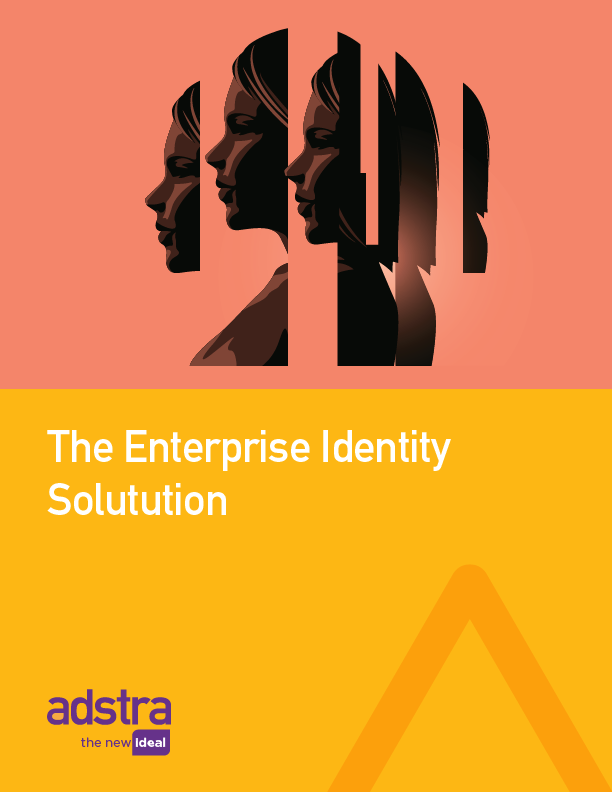Step One:
Lose Control
why brands should bring identity in-house
By Andy Johnson, Adstra


The recent Martech Intelligence 2023 report on Enterprise Identity Resolution Platforms: A
Marketer’s Guide deserves a closer look when trying to understand the crowded market of
identity resolution players.
It’s excellent – a valuable resource to the industry. The report provides an accurate and
thorough analysis of the overall market, framing the question of identity around the issues that
matter most from a marketer’s perspective. Their independent analysis was informed by
detailed interviews and inputs from enterprise identity resolution providers themselves, Adstra
among them.
In that respect, it also reflects some standing assumptions about identity. And there’s one in
particular I’d like to call into question.
Sending Data Out
On page 10, Martech provides a factual rundown of data onboarding. In this context, “data
onboarding” relates to the onboarding of data into an identity resolution provider to resolve IDs
and run other operations.
It reads: “Data onboarding is the first step in the identity resolution process. Client data is
typically onboarded via secure file transfer protocol (SFTP), although several vendors profiled in
this report also provide direct API transfer or pixel syncs. Data is processed with the goal of
establishing a universal view of the customer and includes the following:
● Matching individual identifiers in the identity graph (see below) to associate the customer
with their interactions across touchpoints, particularly online to offline.
● Suppressing unresolved IDs and interaction data for potential future use.
● Hashing or tokenizing personally identifiable information (PII) with an anonymized
customer ID.
● Linking matched IDs to a universal ID representing the customer profile and all of its
associated attributes.
● Validating the accuracy of matches to a pre-established “truth set” of referential data
known to be precise and accurate. ”
Contained in this innocuous description is a fundamental assumption: that in order to run any of
the processes listed above, companies must first send their data out.
This first step warrants more examination from providers and brands alike. Because so many of
the biggest challenges with identity come when data changes hands.
The Step Not Beyond
One of the report’s strongest sections is in laying out an accurate analysis of the challenges to
implementing identity resolution (page 7). To paraphrase, the main challenges are:
● Customer data is often scattered in silos throughout organizations, presenting both
technological and bureaucratic hurdles to sharing consolidated data.
● Poor data quality and low quantities of data can cause low match rates and incorrect
matches in identity resolution.
● Data privacy laws such as GDPR and CCPA/CPRA, present new requirements and
liabilities associated with sharing data with any third party.
The through-line across each of these is the problem of control and transparency – the very
things lost when sharing data between parties.
Data clean rooms, the latest technology to solve this age-old problem, represents just another
third party one must share with. The report found them to be expensive, time-consuming, and
require specialized expertise, with logistical issues arising due to differing privacy laws in
various countries or regions. But most importantly, they don’t by themselves offer any real
identity solution, or the referential set for matching.
What brands need instead is a way to bring the identity resolution process in-house, without
having to develop expensive technology or exceedingly bespoke integrations.
Don’t Mash the Easy Button
Bringing identity behind the firewall does involve some focus to enhance internal teams’
capabilities. While it might not be efficient for every brand to pair investment in tech with
investment in talent, most companies that have moderately advanced marketing programs have
both the resources and a compelling incentive to do so.
In reality, it’s less a question of resources and more one of strategic clarity. It only takes one or
two dedicated people to become proficient with identity and data processing to unlock seismic
gains in the form of more effective marketing spend, transparency, and lowered privacy risk –
not to mention significant cost savings. Unfortunately, these investments are too often looked at
simply as a cost center rather than the key to growing business.
The easy button will always be there in the form of new tech vendors, agencies, and fully
managed services. But for leaders of Fortune 1000 companies, the path to long-term success is
taking control of customer identity and in turn the customer relationship. Digital transformation
takes real leadership from the top, and the involvement of multiple stakeholders from within and
outside the marketing function.
Every one of them has a vested interest in building the capabilities they need to take identity in-
house. As long as brands have to send their data elsewhere to unlock identity’s benefits, they
will never truly control the customer journey.
To access the Martech Intelligence report, click here.



